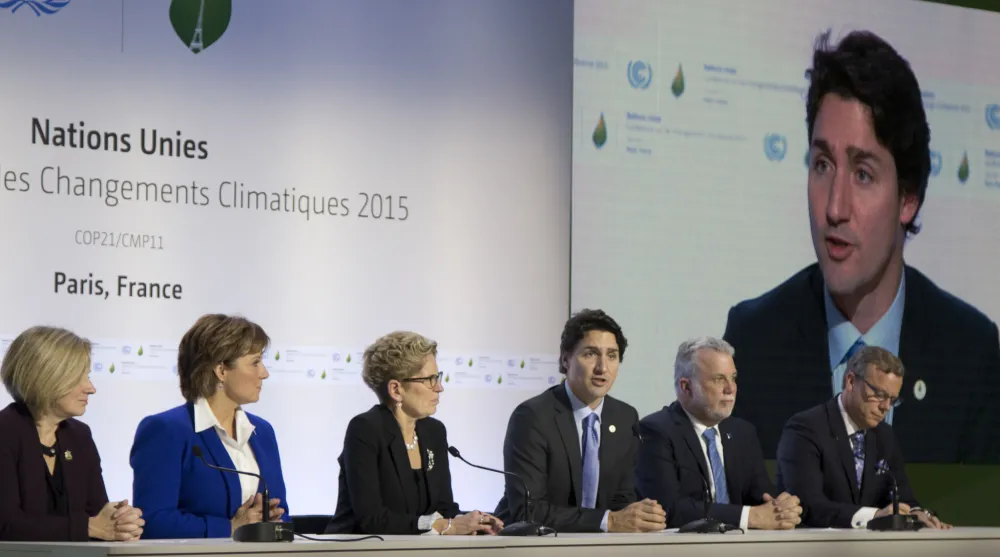This week in Vancouver, the prime minister and premiers will finalize a pan-Canadian climate change framework and establish a process to fill in the details. As we see it, this gathering is an early test of the seriousness of Canada’s leaders when it comes to climate promises made in Paris.
It’s time to turn warm words and strong commitments in the Paris Agreement into real action in Canada. Over the last few years, Canada’s provincial governments have taken important steps on the climate file. Now, the onus is on the federal government to harness that momentum and to build new pathways that will help Canada achieve its domestic and international climate goals.
It will take much stronger action for Canada to decarbonize by mid-century and do our part in striving to limit global warming to 1.5 degrees Celsius. Thankfully, Canada’s Environment and Climate Change Minister has said that her government will build upon the previous government’s climate commitments. As the federal government works to develop a climate change strategy that is both ambitious and achieves Canada’s pledged carbon reductions, here are five key issues the federal government must keep in mind:
A comprehensive tool kit is required: A successful framework will address all major sources of carbon emissions using a variety of policy tools. All levels of government must enact regulations to increase clean energy use and improve the energy efficiency of Canadian buildings, vehicles, and equipment. Government spending on the things we need — like public transit, smart power grids, and electric vehicle infrastructure — will be required. At a time that Canada is trying to reduce its dependence on fossil fuels, all governments should eliminate fossil fuel subsidy programs and quickly phase out coal-fired electricity.
Carbon pricing is part of the solution: Putting a price on carbon emissions that escalates over time is an important element of climate action. It sends a clear signal to businesses, governments, and individuals that carbon emissions have a cost, and emitters will pay (at least part of) those costs. And it creates financial incentives to choose cleaner options. Carbon prices should steadily escalate on an established schedule to achieve the wholesale shift away from fossil fuels by mid-century.
Federal leadership is essential: Provinces and the federal government acting cooperatively and in unison can unlock big emissions reductions. But we’ve seen that some premiers are unlikely to take advantage of opportunities to work with other provinces and the federal government to transition their economies to be competitive in a low-carbon world. We encourage the federal government to build strong relationships with all provinces, but also remember that it has unique tools and obligations.
One key tool is the Canadian Environmental Protection Act (CEPA). Greenhouse gas emissions are considered toxic under CEPA, giving the federal government jurisdiction to regulate. The previous government used CEPA to regulate coal-fired power plants. Unfortunately, those regulations are ineffective. Our current federal government should use CEPA to establish a variety of effective federal measures, including on methane emissions in the oil and gas sector and an accelerated phase-out of coal-fired electricity. Provincial governments can pursue equivalent measures provincially, while provinces without their own measures in place would default to the federal regulations.
A level playing field is needed: The way to maximize ambition is for every sector and every province to take on its fair share of the effort, and be given no more than its fair share of the carbon budget. For Canada to be part of the low-carbon solution, emissions from all sectors and all provinces must be addressed. National unity has been discussed a lot in the current climate change debate but nothing would jeopardize it more than grandfathering large sources of carbon emissions without a plan to achieve overall needed reductions. By the way, the good news is that, if done right, these measures will create jobs, stimulate innovation and strengthen Canada’s economy.
Finally, time is of the essence: Canada must get going on climate action. Canada must look for measures that can be adopted immediately, while remembering that the longer-term goal is decarbonization. As the prime minister and premiers move forward on a pan-Canadian approach to climate change, they must work to close the gap on 2020, establish an ambitious 2025 mark, and strengthen Canada’s 2050 target to reflect promises made in Paris. The federal government should also institutionalize regular reviews of emissions reductions.
The federal government has an incredible opportunity over the coming months to get Canada on the path to real climate action. A transition away from fossil fuels by mid-century is possible but only if the country moves quickly and shows resolve in the face of all challenges. What better place than Vancouver, Canada’s aspiring greenest city, to take the first steps toward achieving this goal.
Tim Gray is executive director of Environmental Defence. Ed Whittingham is executive director of the Pembina Institute. Sidney Ribaux is executive director of Équiterre.






